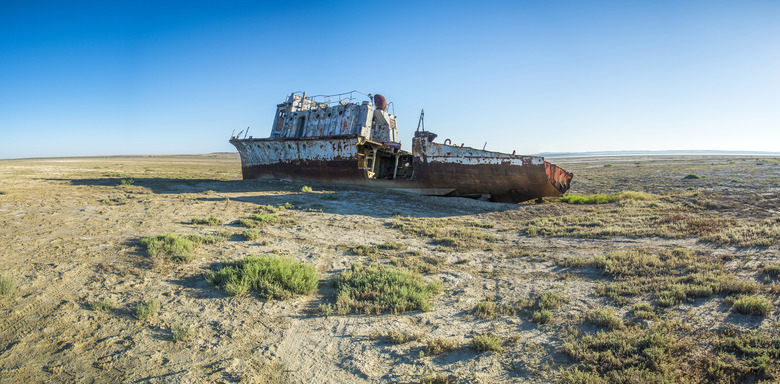An Environmental Disaster Literally Drained This Town's Port
While some land is being swallowed by rising oceans due to climate change (and more land is forming out of debris), some bodies of water are also disappearing. The Kazakhstan town of Aral used to be a major supplier of fish for the Soviet Union, a port city with a population of approximately 40,000 diverse residents. Today that number has fallen below 30,000, and the people of this former port city haven't been able to even see the sea from their town for the last 25 years.
The "sea" is actually a large lake. Lying on the border of Kazakhstan and Uzbekistan, the Aral Sea used to be the fourth-largest lake in the world, behind the Caspian Sea, Lake Superior, and Lake Victoria. Since the 1960s, however, it has slowly been shrinking from its original surface area of 26,300 square miles to 10 percent of its original size by 1997. By 2014, the eastern basin of the lake had completely dried up and was renamed the Aralkum Desert.
This environmental disaster was not a result of climate change, however. The disappearance of the Aral Sea began in 1960, when the Soviet Union diverted the rivers flowing into the sea for the purposes of irrigation in order to grow mostly cotton, but also cereals, melons, and rice.
As the lake dried up, so did the livelihood of the people living around it, nearly all of whom were fishermen. For a quarter of a century, one-sixth of the fish eaten in the Soviet Union came from the Aral Sea. However, the fish started to die in the 1970s. Most of the non-Kazakhs left town, and unemployment skyrocketed. Health problems also began to plague the locals, as the retreating sea exposed airborne toxic chemicals to the wind. In addition, most of the native flora and fauna perished as well, affecting other industries such as the muskrat-trapping industry, which once produced up to 500,000 pelts a year.
Today, Aral and many other former fishing towns are ship graveyards, with fishing boats and ships lying on dry land where the water used to be. Many of them have been sitting there for 20 years.
Efforts have been made, however, to revive the sea. The Kazakhstan government completed the Kok-Aral dam in 2005 — with the help of the World Bank, which financed the project — in order to restore the delta of the North Aral Sea with water from one of its rivers. Whereas the sea used to be about 62 miles away from the shore of Aral, it is now only 16 miles away. Plans are still being discussed for the revival of the South Aral Sea. Hopefully, this will bring prosperity and good health back to the people of Aral and its surroundings. For other harmful destinations, here are 25 places that might actually kill you just by visiting.
